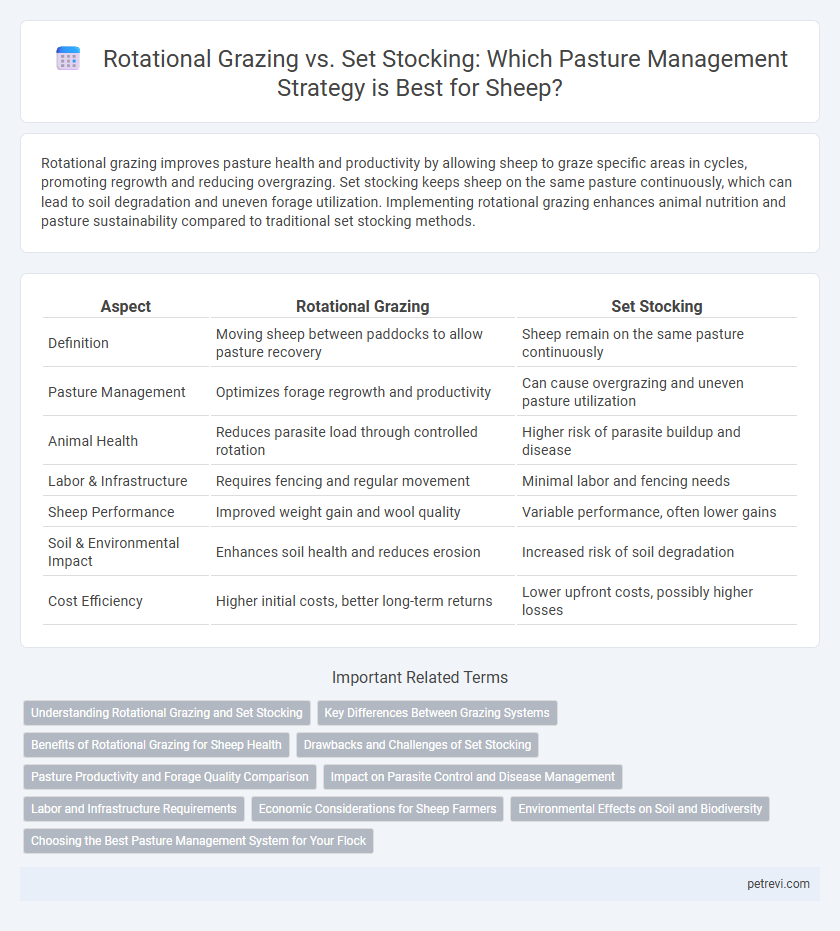Rotational grazing improves pasture health and productivity by allowing sheep to graze specific areas in cycles, promoting regrowth and reducing overgrazing. Set stocking keeps sheep on the same pasture continuously, which can lead to soil degradation and uneven forage utilization. Implementing rotational grazing enhances animal nutrition and pasture sustainability compared to traditional set stocking methods.
Table of Comparison
| Aspect | Rotational Grazing | Set Stocking |
|---|---|---|
| Definition | Moving sheep between paddocks to allow pasture recovery | Sheep remain on the same pasture continuously |
| Pasture Management | Optimizes forage regrowth and productivity | Can cause overgrazing and uneven pasture utilization |
| Animal Health | Reduces parasite load through controlled rotation | Higher risk of parasite buildup and disease |
| Labor & Infrastructure | Requires fencing and regular movement | Minimal labor and fencing needs |
| Sheep Performance | Improved weight gain and wool quality | Variable performance, often lower gains |
| Soil & Environmental Impact | Enhances soil health and reduces erosion | Increased risk of soil degradation |
| Cost Efficiency | Higher initial costs, better long-term returns | Lower upfront costs, possibly higher losses |
Understanding Rotational Grazing and Set Stocking
Rotational grazing involves dividing pasture into smaller paddocks where sheep graze sequentially, allowing plants time to recover and promoting healthier forage growth. Set stocking permits sheep to continuously graze a fixed area, often leading to overgrazing and reduced pasture productivity. Effective pasture management depends on selecting a grazing system that balances forage utilization and regrowth to optimize sheep health and pasture sustainability.
Key Differences Between Grazing Systems
Rotational grazing involves dividing pasture into multiple paddocks and moving sheep frequently to allow forage regrowth, enhancing soil health and pasture productivity. Set stocking keeps sheep continuously in one area, often leading to overgrazing, soil compaction, and reduced forage quality. Key differences include improved nutrient distribution and parasite control in rotational grazing compared to the higher risk of pasture degradation and uneven grazing pressure in set stocking.
Benefits of Rotational Grazing for Sheep Health
Rotational grazing improves sheep health by reducing parasite loads through periodic pasture rest, which disrupts lifecycle of gastrointestinal worms and lowers infection rates. Enhanced forage quality and availability from rotational grazing promote better nutrition, leading to increased weight gain and improved immune function. This management practice also decreases soil compaction and promotes diverse plant growth, creating a healthier grazing environment that supports overall sheep well-being.
Drawbacks and Challenges of Set Stocking
Set stocking in sheep pasture management often leads to overgrazing, causing soil erosion and reduced forage quality. Limited pasture recovery time results in uneven nutrient distribution and increased parasite load, negatively impacting sheep health. This traditional method demands intensive monitoring and can reduce overall pasture productivity compared to rotational grazing systems.
Pasture Productivity and Forage Quality Comparison
Rotational grazing enhances pasture productivity by allowing forage to recover between grazing periods, promoting denser and more nutritious sward compared to set stocking, which often leads to overgrazing and uneven pasture utilization. Forage quality under rotational grazing remains higher with increased leaf-to-stem ratio and crude protein content, directly benefiting sheep weight gain and health. Set stocking frequently results in selective grazing, reducing overall pasture quality and long-term sustainability of the sheep pasture ecosystem.
Impact on Parasite Control and Disease Management
Rotational grazing enhances parasite control in sheep by interrupting the life cycles of gastrointestinal nematodes, reducing pasture contamination and lowering infection rates compared to set stocking. Frequent movement of sheep limits exposure to infective larvae, promoting healthier flock immunity and minimizing the need for chemical anthelmintics. In contrast, set stocking maintains a constant grazing pressure on the same pasture, increasing parasite buildup and the risk of disease transmission among sheep.
Labor and Infrastructure Requirements
Rotational grazing for sheep requires more labor due to frequent movement of animals and management of multiple paddocks, along with investment in fencing and water systems for each paddock. Set stocking demands less daily labor since sheep remain in a single pasture, but it may lead to uneven forage utilization and increased risk of overgrazing, affecting long-term pasture health. Infrastructure costs are usually lower for set stocking, making it a less resource-intensive option compared to the higher upfront expenses associated with establishing a rotational grazing system.
Economic Considerations for Sheep Farmers
Rotational grazing enhances pasture productivity and sheep weight gain, leading to higher economic returns compared to set stocking due to improved forage utilization and reduced feed costs. While initial setup costs for fencing and water systems are higher in rotational grazing, long-term benefits include increased revenue from better animal performance and pasture health. Set stocking may have lower upfront expenses but often leads to overgrazing, reduced pasture lifespan, and decreased profitability for sheep farmers.
Environmental Effects on Soil and Biodiversity
Rotational grazing improves soil health by enhancing nutrient distribution and preventing overgrazing, which promotes microbial diversity and organic matter accumulation. Set stocking often leads to soil compaction and uneven grazing, resulting in reduced plant biodiversity and increased erosion risk. Implementing rotational grazing supports sustainable pasture ecosystems by maintaining soil structure and encouraging diverse flora and fauna habitats.
Choosing the Best Pasture Management System for Your Flock
Rotational grazing enhances pasture productivity and sheep health by systematically moving flocks to allow forage regrowth, reducing parasite loads and soil erosion compared to set stocking. Set stocking involves continuous grazing on a single pasture, which can lead to overgrazing, decreased forage quality, and increased parasite risk, making it less efficient for sustainable sheep pasture management. Selecting the best system depends on flock size, land availability, and management goals, with rotational grazing preferred for maximizing pasture longevity and animal performance.
Rotational Grazing vs Set Stocking for Sheep Pasture Management Infographic

 petrevi.com
petrevi.com